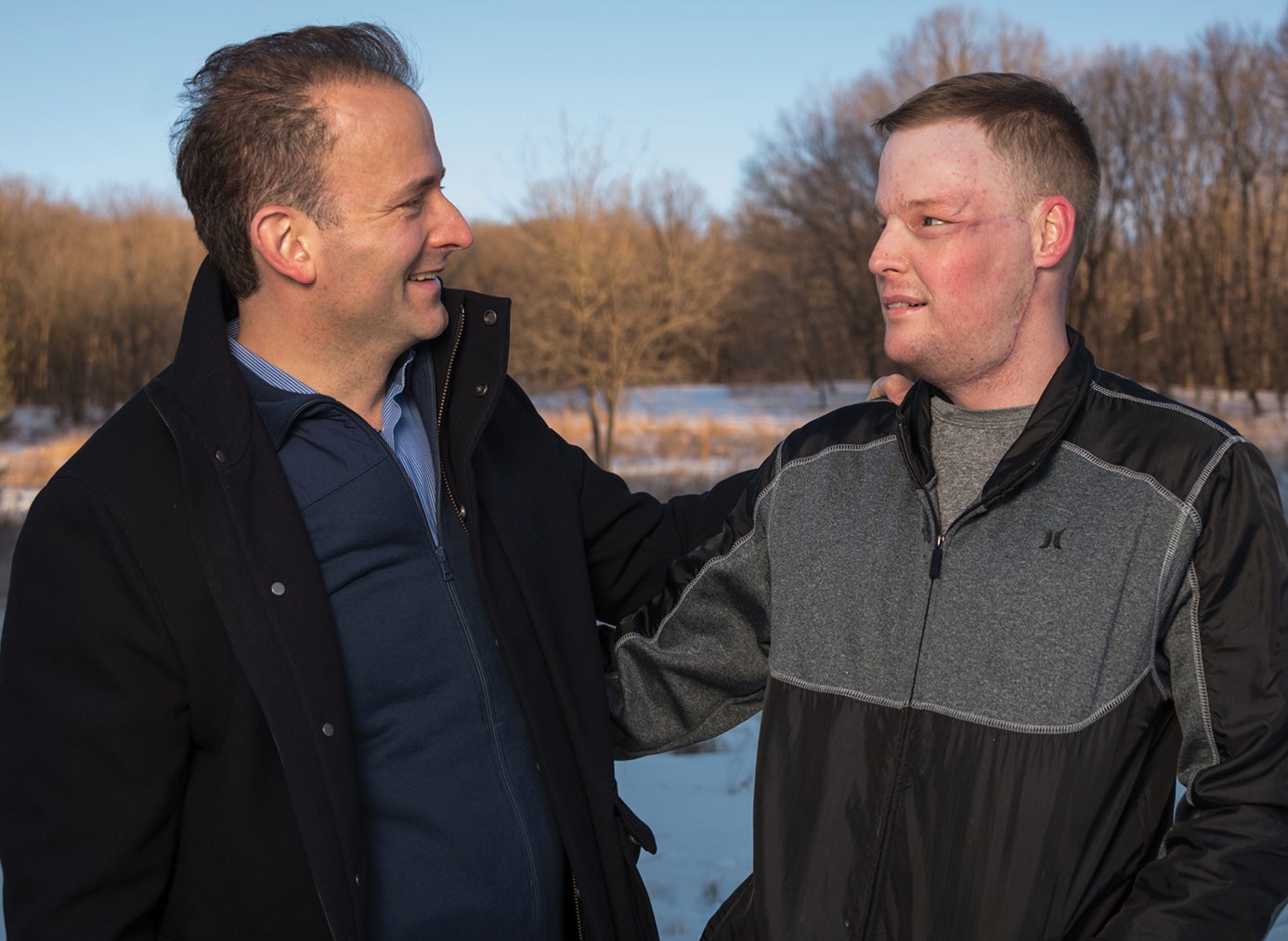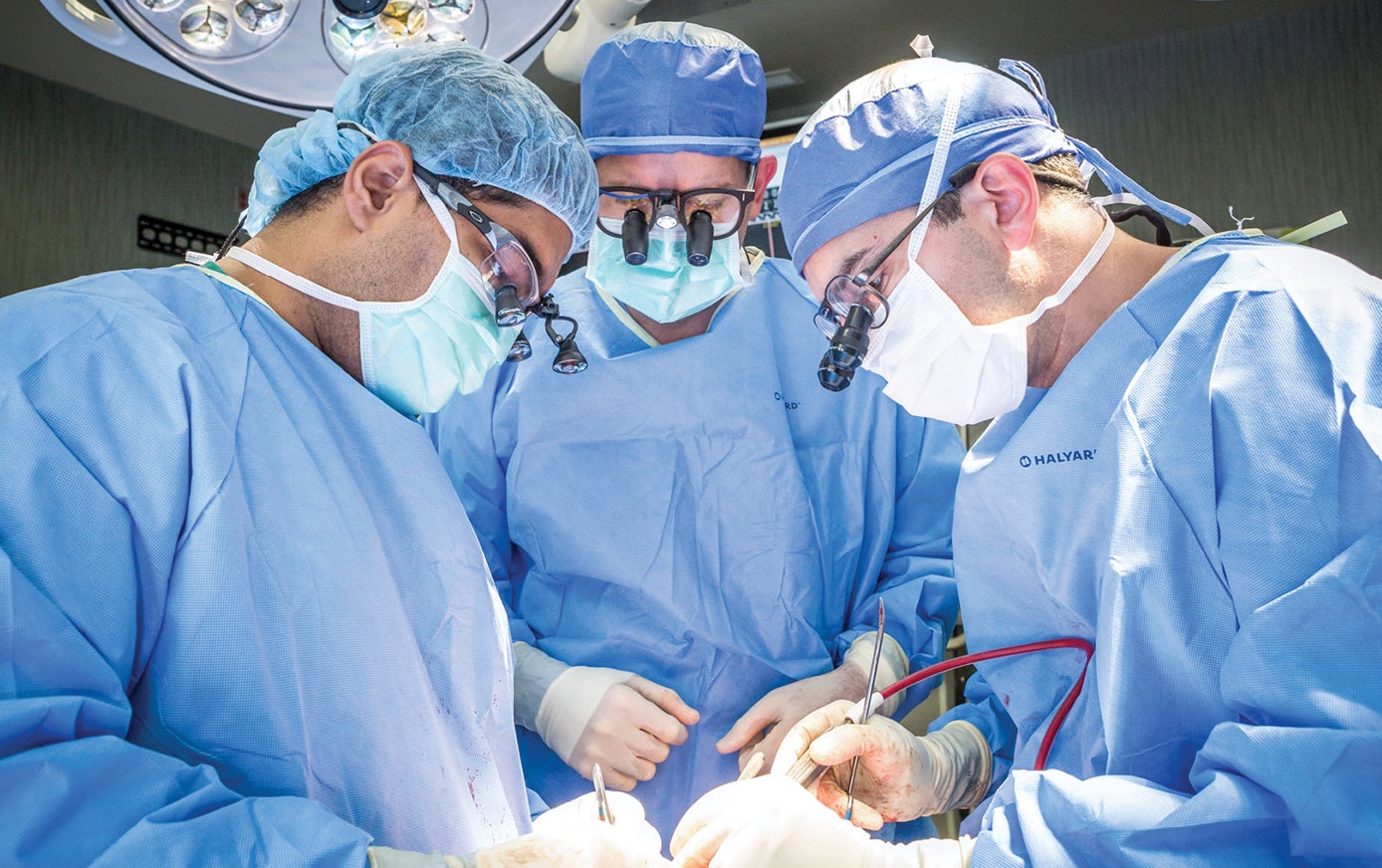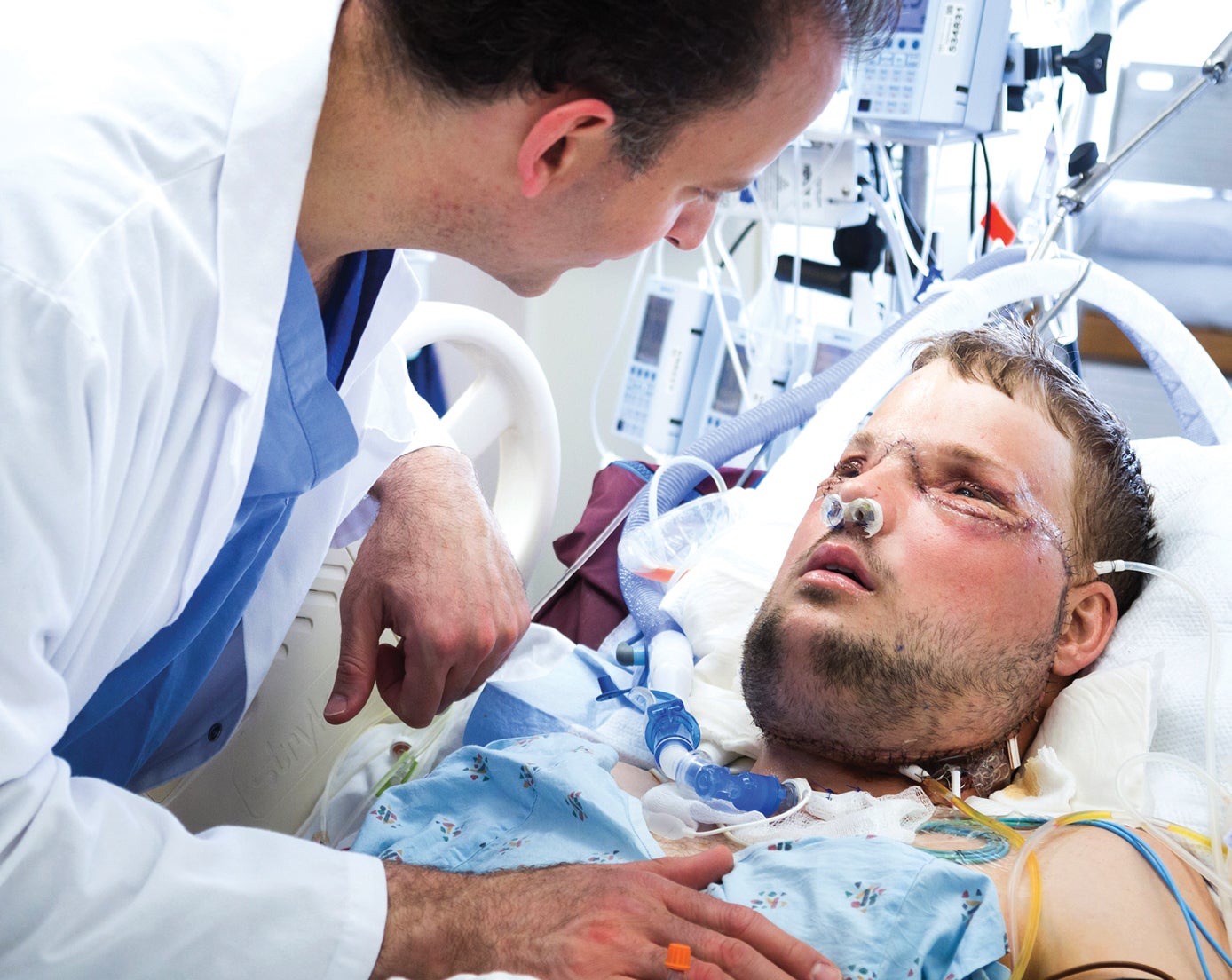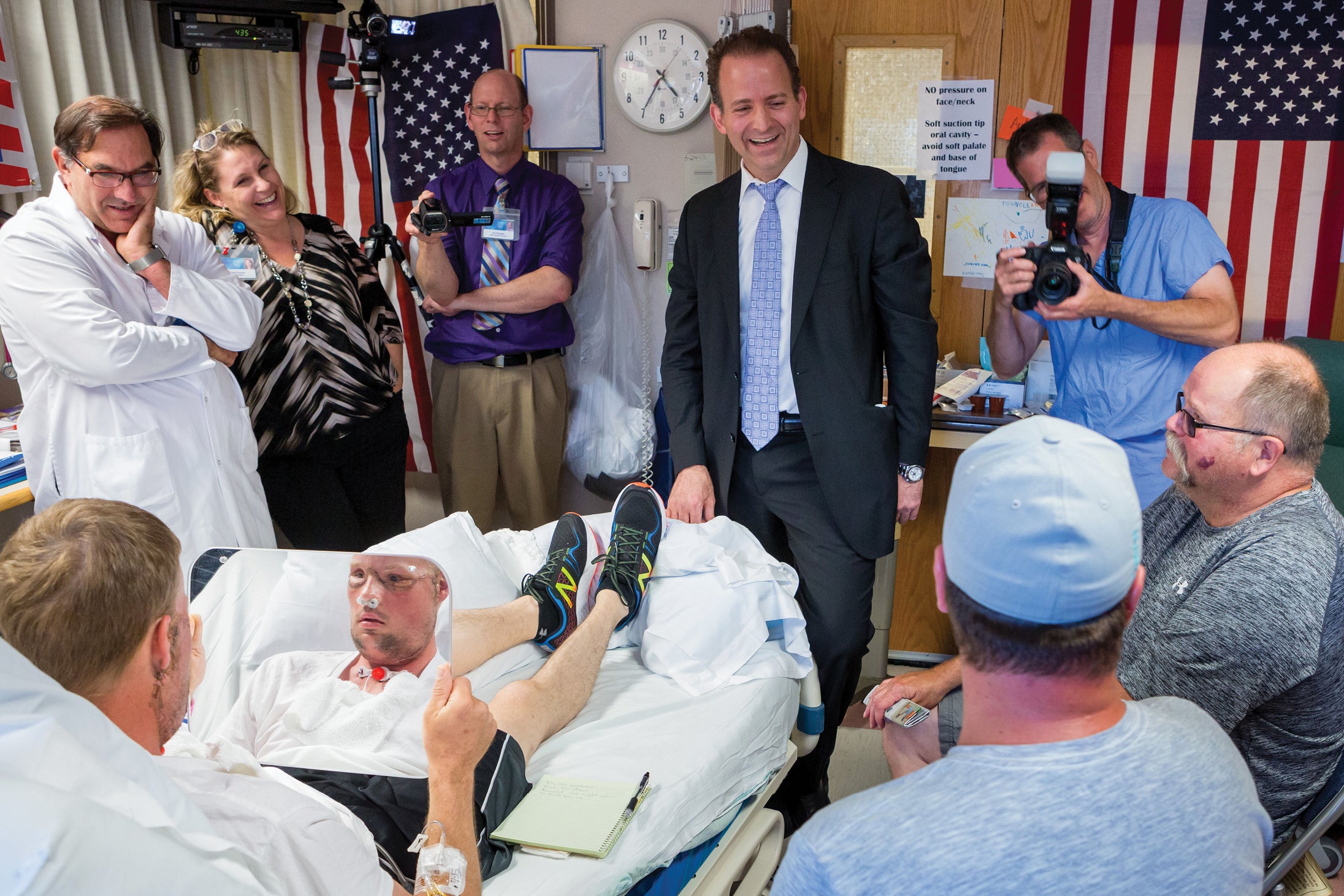When Andy Sandness woke up after his face transplant, what stunned him wasn’t the new hairline or the feel of skin that had once belonged to another man. It was the duration: the surgery had taken 56 hours — far longer than he’d expected.
“We talked about 36 hours,” he recalls, “so I was shocked.” He couldn’t imagine the drama that had played out in the operating room while surgeons worked against the clock to remove his existing deformities and then transfer another man’s face onto his own.
Sandness had trained for years for this moment, lifting weights and doing dips and cardio so that his body would be strong enough to undergo such an extensive surgery. And yet, it would be months before he had the strength to hold a conversation without tiring, years before he felt at home in his own skin. The complications that had arisen during his operation were nail-biting. The plastic surgeon who led the operation, Dr. Samir Mardini, had tried to take a short break during those 56 hours that Andy was under, but with the adrenaline pumping and the scenes running through his mind, he found that he couldn’t switch off — so he went straight back down to theater.
Sandness, now in his late thirties, remains one of only a few people in the world to have received a full face transplant. In 2006, at age 21, he attempted to take his own life with a rifle shot to the face. He survived, barely. The damage was devastating. For a decade he lived with a face that had been reconstructed, piece by piece, in a series of surgeries — functional, but far from natural. Children would point at him in the street or ask their parents what they were looking at. Adults would widen their eyes then quickly look away.

His was not the first face transplant. That milestone belongs to Isabelle Dinoire, a French woman mauled by her dog in 2005. But Sandness’s surgery, performed in 2016 at the Mayo Clinic in Minnesota, marked a quiet milestone in the American history of facial transplantation: a pivot from possibility to permanence. It was a test case not just of surgical technique, but of ethics, identity, and time.
Dr. Mardini says the team trained for over three years before they even had a recipient. Fifty weekends were spent in the cadaver lab with doctors, nurses and even medical photographers, painstakingly transferring the faces of dead people onto the bones of others.
Even as they prepared, they didn’t know if their efforts would come to anything. A face is not like a singular organ, where the tissue is all the same and the major veins and arteries are obvious. A face has skin; muscular tissue; parts of bone; tiny blood vessels; nerve pathways crucial for touch, sight, and the ability to swallow and eat. Eyelids, nostrils and lips come in certain sizes. Hairlines have to match up. Skin color and tone needs to be close to the recipient’s. All of these factors mean that finding a match on the donor list is close to impossible.
Then, not far away in rural Minnesota, 21-year-old Rudy Ross compulsively took his life in earshot of his wife, Lilly, following an argument. Lilly called an ambulance immediately, but it was clear that Rudy could not be saved. What made Rudy’s death so tragic is abundantly clear — he was young and healthy, with his whole life ahead of him and no history of major disease — but it’s also what made him an ideal candidate for organ donation.
A Race Against Two Clocks
By the time Rudy Ross’s body arrived at Mayo Clinic, everything was in motion. Gravely sick people who had been waiting at the top of the transplant list across the country were told that the organ they needed was on the way. In these kinds of situations, a kidney can be headed to Alaska while a liver is earmarked for Texas and a heart is needed in Pennsylvania. Each hospital sends a team to take the organ back to their waiting recipient.
When you add face transplantation into this mix, things get complicated. Rudy’s wife had been suddenly widowed. She was eight months’ pregnant. And while Rudy had agreed to donate his internal organs by ticking the requisite boxes on his drivers’ license, his face had never been promised. That had to be negotiated.
The families who “might be approached by the organ procurement organization to talk about the face” are usually those who already know their loved one wanted their internal organs to be given, says Dr. Mardini. “So there’s already a sort of open discussion… Your loved one has signed off on their drivers’ license that they would like to give the gift of heart donation, lung donation, kidney donation — but we have a patient at Mayo Clinic that is in need of a face. Is this something you would consider?” That topic is introduced only if the donor is a clear match, which was clearly the case for Rudy and Andy.
“I got chills,” says Dr. Mardini, recalling how he felt when he saw Rudy’s face. The two men “could have been cousins.” After a difficult period of reflection, Lilly agreed that her late husband’s face, as well as his internal organs, could be taken.

Two operations were required to be undertaken at the same time in order to transplant Rudy’s face onto Andy, and Mardini was in charge of both. The two men were placed in side-by-side operating theaters — Rudy, braindead but stabilized, and Andy, anesthetized and closely watched — and Mardini carefully removed Rudy’s face before running it into the adjoining theater and attaching it to Andy’s.
Carefully removing all of the tissue surrounding the face is delicate. And preparing the recipient to receive all those veins, nerves and muscles is a procedure in itself, one that borders on the horrifying.
“Andy’s was a significant surgery in that it involved the entire upper jaw, lower jaw, the cheekbones, the mandible and the nose and teeth and all the overlying structures,” says Mardini. “So you’re talking about the nose and then lower eyelid and below, and then deep from the skin all the way down to the bone. You need to remove everything that’s remaining there. That’s to accommodate the donor to come in. So you’re at the end of it, and you’re staring at the greater vessels, the carotid and the jugular. You’re staring at the tongue and the eyeballs, and everything else is gone.” It’s something that he and the rest of the team had to prepare for, not just in terms of “the technical part, but the emotional and mental part.” No one is used to seeing a living human without a face.
The fact that all this work has to be done to remove the underlying tissues also means that the operation is extremely high-pressured. There’s no going back in a face transplant, no putting the old organ back in and trying again next week with something else. Failure is quite simply catastrophic.
Jack El Hai is an author who spent five years with Andy Sandness and his medical team, and was in the operating theater as the pioneering surgery was performed. He got to know the process intimately and interviewed multiple members of the medical team as it had happened. He remembers a moment where things got particularly tense in the operating room.
“There was a moment in the placement of the donor’s face onto Andy when an important blood vessel narrowed or collapsed or went into spasms,” he says. “And it took a long time — or it seemed like forever, it was probably just a matter of minutes — but it took a while for the surgical team to figure out what was going on and why, and how to fix it. They noticed that while that blood vessel was constricting, Andy’s face went white. It was obvious it wasn’t getting proper blood flow. And that had to be fixed immediately.”
As the team struggled to work out what was happening, El Hai felt the mood in the room shift. Andy’s old, reconstructed face had been cut away. There wasn’t really a Plan B, beyond “a gaping opening in his face that somehow would’ve had to be patched using skin from other parts of his body.”
Painful Priorities
There is another issue with taking a face from a donor who also has healthy organs that are waiting to be procured for other people in dire health situations: “The way it works best is to have the face donation go first,” says Dr. Mardini. “And that makes it very tricky, because you’re dealing with a ‘life-giving’ operation versus a ‘life-saving’ operation.”
Globally, only around 50 face transplants have ever been performed. The rarity isn’t due to a lack of demand. Patients with devastating facial injuries — most often from trauma, cancer, or infection — face profound physical and social barriers. A functioning face is not just about appearance; it governs speech, eating, blinking, and expressing emotion. Traditional reconstructive surgery can require dozens of procedures and still fall short of restoring those functions. A transplant offers, in some cases, a faster route to a more complete face.
But the barriers are steep. These operations require staggering surgical precision: connecting those nerves, blood vessels, and bone with millimeter-level accuracy. Then there’s the immunological gauntlet. Patients must commit to a lifetime of immunosuppressive drugs to prevent rejection — medications that can cause serious side effects, from kidney damage to cancer. Isabelle Dinoire died of a cancer related to low immunity 11 years after her own partial face transplant.
Mayo’s team had to prove to the organ procurement organization — and to their peers — that their procedure wasn’t a vanity project. It was an operation that could restore breathing, eating, speaking, the ability for a person to live a normal life. It was reconstructive and transformative, not simply cosmetic. Still, the optics were fragile. There was no precedence in the U.S. for prioritizing a face over a lung. And the team also had to convince their own hospital that Andy Sandness, a man who had previously attempted suicide, would work hard to make the transplant worth it, complying with a regimen of immunosuppressant drugs throughout his life and continuing the work he’d put in for years previously. That meant psychiatric assessments and social workers on top of all the other medical considerations.
Different organs have different rates of depreciation, but all have a small amount of time when they remain viable after death. Keeping Rudy Ross stable enough that those other organs stayed healthy was a huge undertaking in itself. Ordinarily, the heart and lungs need to be taken within four to six hours of death, the liver within eight to twelve, and the kidneys within 24 to 36, according to the nonprofit Donor Alliance.
Removing the face from Rudy “took longer, I think, than [Mardini] expected, more than 20 hours,” says Jack El Hai, “meaning there were other surgeons waiting in the wings to remove the other organs that the donor had given permission for them to take, and it got tense. They were getting impatient. They were worried about the health of those organs that they were waiting for.”

Mardini had given time frames to the surgeons who were arriving from elsewhere to pick up their organs, but those time frames had to be extended in theater. He had also assembled an in-house team to remove the organs immediately if Rudy Ross destabilized, who were ready to step in at a second’s notice.
Though the surgery was long and delicate, it worked out in the end. Rudy’s organs went on to save the lives of a number of desperate people, something that was especially important to his widow, Lilly. The details surrounding exactly how many organs were taken have not been released, to protect the privacy of the patients who received them. However, we do know that no organ was compromised by the face transplantation going ahead. That, in itself, is close to a miracle.
What’s Left Behind
Miracles in medicine are earned, not bestowed. And Mardini’s team had worked hard to earn theirs: during their weekends in the cadaver lab, they had transferred the biggest possible face onto the smallest possible skull and vice versa; they did CAT scans and drew complex plans of bone and blood vessels in the way an architectural team might put together plans of concrete structures and plumbing.
A new story began for Andy Sandness when he woke up with Rudy Ross’s face. But first, Ross’s story had to come to a dignified close. Four years earlier, an expert team in developing silicone facial prosthetics had agreed to come down to the cadaver lab sessions and learn how to construct a mask of an entire face. The team had previously made lifelike prosthetic noses, eyes and ears for people with deformities or serious injuries; in the lab, they molded masks that were indistinguishable from the original faces, “with the freckles and the wrinkles and the hair,” says Mardini. Once Rudy Ross’s body arrived at the clinic, they were called in to do the job they’d trained for over a number of years. Fourteen delicate layers of material were carefully woven together and shaped, in order that his body could return to the funeral home looking recognizable, in a process that took 14 hours.
Lilly Ross had planned for a closed casket funeral after she’d agreed to her husband’s face to be transplanted onto Andy Sandness. But when the Mayo Clinic released Rudy’s body, complete with silicone mask, Mardini says they received a call from the funeral director: “He kind of paused then said: ‘I think you sent me the wrong body, because there was going to be a face donation’. And when it turned out it wasn’t the wrong body, he called up the wife and the mom and said: ‘You might want to come and visit with the body’. And they did an open casket.”
Looking Like Yourself, As Someone Else
Although he has Rudy Ross’s face, Andy Sandness doesn’t look like his donor. That’s because one’s underlying bone structure is just as important for how a person’s face looks as the individual components. That was a relief for Rudy’s widow Lilly — who met with Andy a few times, although they eventually lost touch as they both moved on and had further families — and for Rudy’s mother, who Andy stayed in touch with until her death.
“Andy is one of the rare people in human existence who has had three faces during his life,” says Jack El Hai. “The one he was born with, the reconstructed face, and then the transplanted face.” Such huge aesthetic changes can be a shock to the system, and psychological issues with carrying someone else’s face or limbs have led to people requesting removal in the past. “So the social workers and the psychologists led him through what they called a gradual reveal,” El Hai continues, “which meant seeing pieces, portions of his face in the mirror, a bit at a time, gradually, from a distance and up close. And this helped Andy become reconciled to his new appearance.”

In El Hai’s opinion, Andy — who he describes as a thoughtful and quiet man who came out of his shell after the face transplant — “looks great” these days. “I always tell people that I think he looks like Matt Damon,” he adds.
Sandness remains a private man, however, who prefers to do media interviews over email rather than in person or over the phone. Eight years after the surgery, functionality, he says, is good. He’s legally blind in his left eye but has some peripheral vision. “My nerves and feeling in my face improve daily,” he says. “But there is more I could do as far as exercises to improve what I have.” His progress has been steady but incremental, often invisible to outsiders.
The internal work has required just as much effort as the external. When I ask him what’s overlooked about his experience, he says it’s a “complicated” question, because at first he thought he should mention the time and dedication from everyone involved that goes into a face transplant. “But the more I think about it, it’s definitely not repeating suicide to my friends, family, and doctors,” he says. When he woke up after attempting to take his own life, “I was embarrassed, humiliated, and depressed.” Over the years, he’s accrued a whole team “of psychiatrists, psychologists, and family and friends that all believed in me,” and that’s been humbling. He keeps in mind that he would never want to let them down.
“I have a hard shell but a big heart,” he continues. “I will go out of my way to help people out. But I will never ask for help in return, even when I know I need it. I’m stubborn as a mule and do things how I see fit.” It’s a mentality that may have led him to suicidality when he was younger. But it’s also a mentality that he believes helped him pre-transplant: he kept going, even in circumstances many would have found unbearable. Asked if he’s an organ donor himself, he replies simply: “Of course I am.”
Dr. Mardini never thought he’d perform such a complex operation as a plastic surgeon. But the change in Andy Sandness’s life is clear: “He is able to swim. He is able to eat and drink in a restaurant. He is able to interact normally with people,” he says. Recently, Andy described a quiet moment that signaled, to Mardini, that he and his medical team had achieved everything they’d wanted to when they first set out, years prior, to perform the pioneering transplant.
“When he walked in an elevator, this kid and his mom walked in after him,” Mardini recalls. “The kid looked at him, looked away and kept talking to his mom. And everything was fine.”
Jack El Hai’s The Face in The Mirror is published on May 20th
If you are based in the U.S. and you or someone you know needs mental health assistance right now, call the National Suicide Prevention Helpline at 1-800-273-TALK (8255). This is a free, confidential crisis hotline available 24 hours a day, seven days a week. If you are in another country, you can go to www.befrienders.org to find a helpline near you.
If you are experiencing feelings of distress, or are struggling to cope, you can also speak to the Samaritans, in confidence, on 116 123 (UK and ROI), email jo@samaritans.org, or visit the Samaritans website to find details of your nearest branch.